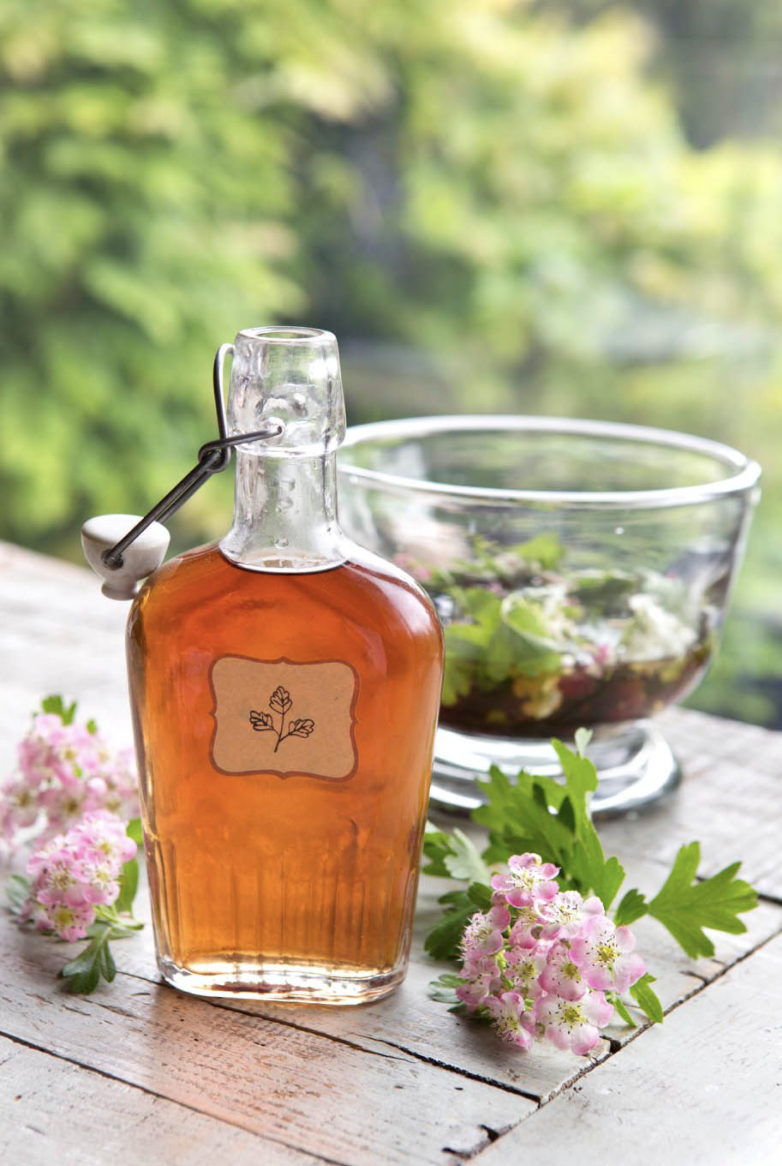Hawthorn shrubs are a common sight in wild and garden hedgerows, making a beautiful display with their spring pink and white blooms and later in autumn with their plump red berries.
The berries are traditionally used in herbal remedies for anxiety and grief. More recently, research has highlighted their cardiovascular (circulation) protective properties, their ability to modulate low and high blood pressures and treat chronic heart failure (1)*. This is thought to be due to the high content of antioxidant polyphenols called oligomeric procyanidins (OPCs). Research shows the flowers are even higher in these OPCs, so herbalists combine both flower and berry for use in the herbal dispensary.
The shrub is in the Rosaceae (Rose) family, members of which also have cyanogenic glycosides, which in greater amounts can be converted to cyanide (think apple pips) but in lower amounts give us tasty almondy flavours. Almonds and apples are related to hawthorn, and like apples, each tree can have widely different flavoured berries. Nibble away around your neighbourhood to find your favourite tree. Like almonds, the flowers have a mild marzipan taste which is brought out by the brandy.
Infusing the flowers and berries in brandy makes a delicious liqueur that can be used as a tasty tipple or taken for those moments of stress, or for gently soothing for those who are experiencing grief. It also makes a lovely seasonal gift.
This recipe was taught to us by late herbalist Chris Hedley who reckoned all people over 65 should take a little a day to protect their hearts.*
For more on hawthorn identification, see our blog here.
HAWBERRY-FLOWER BRANDY RECIPE:
Phase 1 (Spring)
Hawthorn flowers, enough to loosely fill a mason jar, any size
Brandy (see below for alcohol alternatives)
Sugar Or Honey 1 -3 Tbsp (Optional)
Phase 2 (Autumn)
Hawthorn Berries
Method
Phase 1:
Fill a mason jar loosely with haw flowers. Ideally, gather flowers that have some buds open, and some buds closed. (see image). Tese fresh flowers have pinkish pollen, old ones have gone brown and taste a bit cheesy. Cover with brandy and push or weigh the flowers down to keep submerged or they oxidize (ramekins do the trick).
Label, date and leave to infuse for one month, gently shaking occasionally.
After one month, strain and squeeze out the liquid from the flowers, discarding the blooms in the compost.
Return the liquid to the mason jar and store in a cool dark place. It is ready to use now but is even better if you have the patience to double infuse in the autumn when the plump. glossy berries come out.
Phase 2:
Gather ripe berries (they will be slightly soft when squeezed), and half fill a mason jar with them.
Pour over the hawflower brandy to cover. They have more volume than flowers, so you may need to use a second jar.
Add the sugar and infuse for another month. Don’t leave it for longer or the tannins inside condense and leave the brandy looking a bit rubbish, like how a cup of tea left for ages gets that strange sheen-film on top. It can still be used, but doesn’t look as pretty for gifts.
Strain, bottle, label and date.
TO USE: As A You Would Any Occasional Tipple
SHELF LIFE: Up To 2 Years In A Cool Dark Place.
ALCOHOL ALTERNATIVES: 1) VInegar can be used instead of brandy, but isn’t quite as tasty and has a shorter shelf life, around 1 year. 2) Edible glycerine can be used as well. to make glycerites 3) You can dry the flowers and berries to use in infusions.
(1) Guo, R., Pittler, M. H., & Ernst, E. (2008). Hawthorn extract for treating chronic heart failure. Cochrane Database of Systematic Reviews, (1).
* Check with a herbalist first if you are interested in taking hawthorn medicinally for heart conditions.



